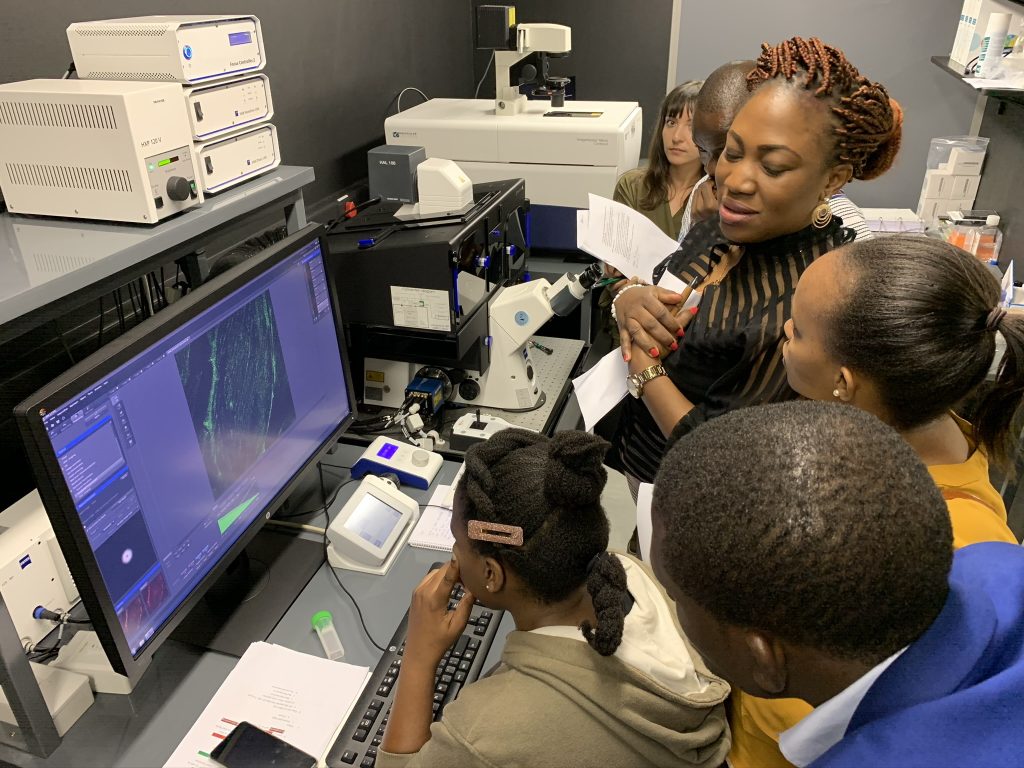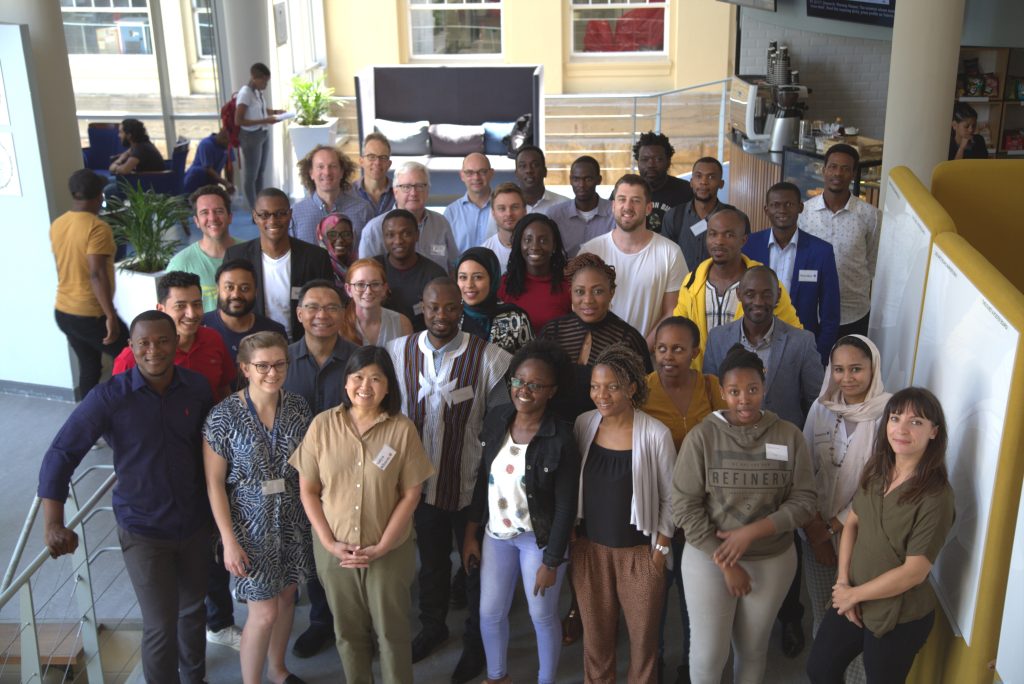Microscopy in Africa – an interview with Michael Reiche
Posted by Helen Robertson, on 29 July 2022
We caught up with Dr Michael Reiche, Director of the new Africa Microscopy Initiative (AMI) Imaging Centre, to learn about microscopy initiatives in Africa and the three different programmes (AMI, African Bioimaging Consortium and Imaging Africa) he is overseeing.

To begin, can you tell us how you got involved with the microscopy community in Africa?
I did my undergraduate degree at the University of Pretoria and my graduate studies at the University of Cape Town in South Africa. During my PhD, I contacted the Advanced Imaging Center (AIC) at the Janelia Research Campus to try and perform an experiment under their visitor programme. This was my first truly eye-opening exposure to microscopy. When I finished my PhD in 2018, I reached out to the AIC as part of a general job search, and the Director of the AIC, Teng-Leong Chew, interviewed me for the Advanced Microscopy Imaging Fellow role, which I ended up landing. To be honest, I went in with limited microscopy expertise, but I felt I had a good grounding in biology and was eager to learn. I was also quite passionate about teaching people about microscopy and enabling others in using it. I wanted to make sure that the good fortune I had to be working at Janelia benefited more than just myself – and therefore tried to find a way to help infectious disease researchers back at the University of Cape Town get in touch with microscopy.
At one point, the idea of an imaging workshop came up and so we hosted a workshop for African scientists and called it Imaging Africa. We received a huge number of applicants – over 700 for only 24 positions – and were quite blown away by the clear demand for microscopy training throughout Africa. In collaboration with the Institute of Infectious Disease and Molecular Medicine, we held the workshop in Cape Town, and through discussions with the attendees and some follow-up Zoom calls, including with Dr Caron Jacobs, who’s a CZI Imaging Scientist working at the University of Cape Town, we got the impression that there was no centralised area for African researchers to gain information on microscopy. It was clear that forming a microscopy-related community would be very beneficial to research in Africa. This led us to hold a community meeting that ultimately initiated the African Bioimaging Consortium (ABIC) as a formal venture.
How has the African Bioimaging Consortium grown since then?
This all began during the pandemic in 2020, and we quickly saw a lot of growth and interaction and started reaching people that we hadn’t worked with before. Most of the many ABIC initiatives have come from the community. Overall, we are now working towards establishing a centralised platform that can synergise existing efforts, improve communication between different research groups and utilise existing resources in Africa as best as possible.
What are the main objectives of ABIC?
A lot of our objectives were formalised with the ABIC application for funding from the Chan Zuckerberg Initiative grant, as the funding call coincided with establishing our aims early on. That round of funding was for increased accessibility to bioimaging resources across the globe – one aspect of this was related to core facilities, and the other was geared towards community initiatives, which we fit into.
Our primary objective was to establish a network where researchers can find one another and get information on what equipment and expertise is available across the continent. This leads into another aspect of our objectives: intra-African collaboration. Presently, researchers look to Europe and North America for collaborations. This might be beneficial in the short term as it allows researchers to access the technologies they need for their research, but it’s really to the detriment of African research in the long term as the imaging happens elsewhere and capacity is not developed locally. Sometimes samples are shipped out, so the researchers who took the time and effort to gather them never see what happens at the imaging stage and they don’t gain that knowledge. If we can build a network that enables access to microscopes in Africa, then researchers no longer need to look abroad. On our website we have a map of Africa that we’re using to label where resources and expertise are, so that collaborations can be fostered more easily.
A good portion of the funding is earmarked towards paying the salary of someone to coordinate ABIC, as it is not sustainable for us to do this during our spare time. The funding also enables us to host an in-person Community Meeting prior to the second Imaging Africa workshop in Cape Town this October, and I hope there will be synergy between the two events. Later this year we also hope to announce a travel fellowship that will pay for researchers to travel within Africa. This will be based on two criteria: firstly, a pilot study travel grant, which is purely for researchers to perform microscopy-based experiments for the first time, with an understanding that the experiment might not work perfectly. This is to get over the hurdle of trying something for the first time, as many researchers might have the assumption that microscopy isn’t right for them because they’ve never done it before. The second travel grant is for a formal collaboration between two researchers at institutes in Africa. In addition to this, we also plan to host more events online in the future.
Lastly, we have two working groups that were defined by the members of the community: one on training, education and awareness that is working to develop an introductory microscopy curriculum for researchers in Africa, and a second group to assess infrastructure and accessibility.
To summarise, our overriding mission is to form a cohesive community where existing resources and efforts can synergise to become more visible and accessible to researchers across Africa. And with our unified community comes the benefit of having a voice in the global community and integrating with other efforts across the world. The support we have had from the other microscopy communities and initiatives across the globe has been phenomenal.
“Our overriding mission is to form a cohesive community where existing [microscopy] resources and efforts can synergise to become more visible and accessible to researchers across Africa.”
Of course, microscopes and related technologies are very expensive – what accessibility is there to this equipment in Africa at the moment?
The short answer is that unfortunately accessibility is not great. Personally, I’m very conscious that I’m located in Cape Town. For Caron and I and UCT to be representative of all of Africa is completely wrong, and that’s not what we are trying to do. We’re cognizant that the community consists of people in a variety of settings, such as Tanzania and Ghana and Sudan and that they experience accessibility very differently. An illustrative difference is the fact that travel across Africa is sometimes very challenging. For example, funders don’t necessarily understand that it can take more than six months to get a visa to travel to another country. If you’re facing these types of barriers, it’s naturally going to impinge on your research, too. Despite these challenges, there are a few core facilities in Africa that offer external support and help – it’s just that researchers don’t know about them. I learned of a core facility in South Africa, maybe 600km away, that I’ve never heard of before! So, it’s these awareness and accessibility issues we’re trying to tackle.
Are there any other initiatives in Africa to support this?
Actually, I am very excited about the recently launched African Microscopy Initiative (AMI)! This is a much larger endeavour than either Imaging Africa or ABIC, and it’s being spearheaded by my mentor at the Janelia Advanced Imaging Center, Dr Chew. Following on from the success of the AIC at Janelia, he started to think about the steps necessary to begin rectifying the entirely absent pipeline for microscopy in Africa. We have secured significant support from CZI and the Bill and Melinda Gates Foundation to launch a fully open access lab which will run on a very similar model to that of the Advanced Imaging Centre. That is, we will be opening a lab at the University of Cape Town with dedicated commercial microscopy equipment. We will cover the cost of accommodation, the cost of the experiments, and the use of the microscopes, along with assistance, for any researcher in Africa to come to the facility for up to a month. Some of the microscopes will be the first of their kind on the continent, and they will be entirely freely accessible, including the cost of travel to get here. We’ll host open calls inviting researchers to propose their experiments, and we will do all we can to pay the expenses for them to come and carry out any research that is reasonable and justified. But the facility won’t stand alone as a place to come only when you have a perfect experiment planned: we will also be open for consultation; so if researchers don’t know where to start, they can reach out to us for technical advice and if necessary, put them in touch with researchers who have experience in what they want to do.

Another part of the African Microscopy Initiative is a push for training. An AMI programme called the Partners in Teaching (PiTCH) fellowship will pair aspiring imaging scientists from Africa with researchers from outside Africa to jointly host a workshop at the African researcher’s home institute, and we hope that will start developing expertise locally. The third and final AMI programme is a little trickier – a programme for equipment exchange and redistribution (PEER). We know that when new microscopes are deployed at universities in the Global North, the old microscopes often go to waste. We’ve been working with Zeiss Microscopy, which is just one part of the Carl Zeiss Foundation, and we’re trying to find a way of re-distributing these microscopes to African institutes based on institutional motivation. The aim is to cover the costs of delivering and installing the microscopes but also train researchers at the institute on how to use and maintain the instrument with the intent to make it a sustainable shared resource. And that aspect of maintenance and keeping the microscope working is really important – it means that more instruments are available to the broader research community, too. All these initiatives help one another and will offer a lot to the research community here in Africa.
That sounds like a really brilliant project – you must be so excited to launch it!
I am very excited; it’s going to be really great! We’ve started to tell people about AMI at various meetings and the response has been fantastic – they want to do all these experiments, and finally it’s going to be possible!




 (4 votes, average: 1.00 out of 1)
(4 votes, average: 1.00 out of 1)

This is great! i have been motivated a lot as a scientist and how i wish i will be part of this team to take microscopy to a higher level in Africa.Even to install the microscopes in my own country then more limited researches will be possible!
Thank you for implementing this initiatives in Africa.
Thanks Mike for this project’s story of microscopy in Africa with the aims and steps. I learned and undestood better how AMI starting with your phD in AIC, then imaging Africa (2 sessions 2018) after ABIC (2 awards: pilot and collaborative) and finally wondrous lager AMI ( 3 main steps open -access with calls, Trainings with Pitch and Equipement with covered costs and full training of for usage and maintenance of old unused microscopes. After listening i’m still more excited about AMi and i wish all the success with my contribution